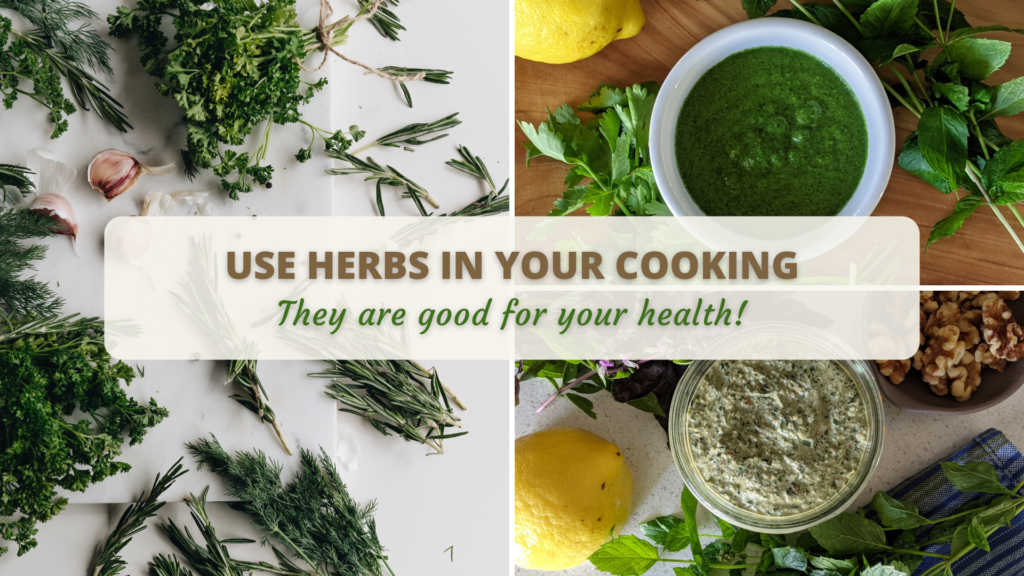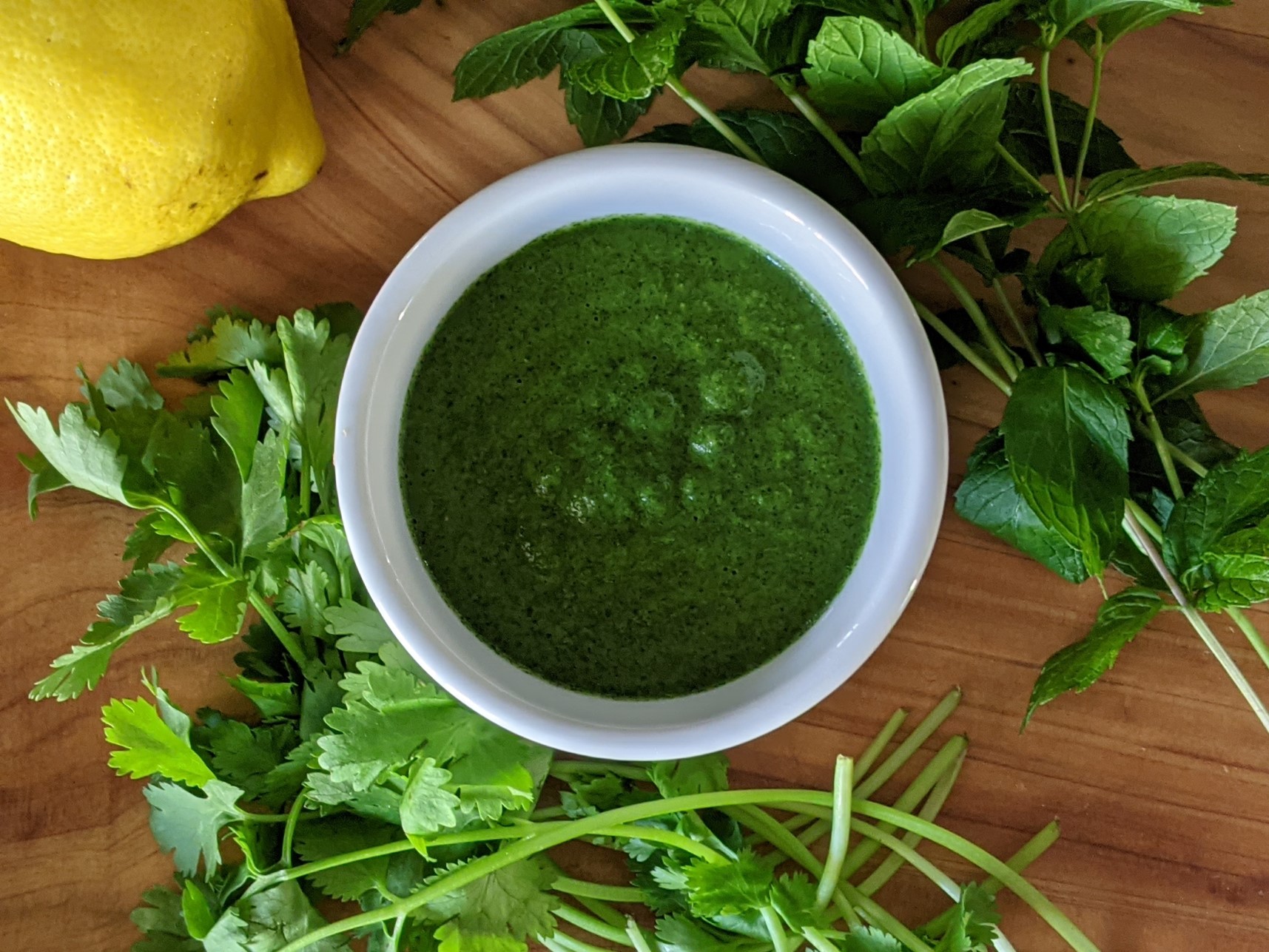Join our mailing list to receive the latest health tips and updates.
You have Successfully Subscribed!
Take Advantage of the Abundance of Herb Harvest in Late Summer (Recipes Included)

Happy Labor Day weekend! (to those in North America)
Labor Day often reminds us that we are moving towards late summer.
At this time of the year, many summer herbs and vegetables are in their mature and abundant stage. You may notice that in your own garden or at the farmers’ markets.
We can take advantage of the abundance of harvest in our meal preparation, in particular herbs, because herbs generally have much higher antioxidants and anti-inflammatory properties than vegetables.1
But how do we consume an abundance or even overabundance of herb harvest at this time of the year, since herbs are normally used more sparingly in cooking?
In this article, I share a couple of delicious recipes and tips that can make use of larger quantity of herbs. You can adapt the recipes to experiment with different mix of herbs. The recipes also allow you to store the prepared dishes for later consumption, e.g., during fall and winter when fresh herbs are harder to find.
In addition, the health benefits of some common culinary herbs, as shown by scientific research, are also discussed.
Health Benefits of Culinary Herbs
Herbs contain many phytonutrients including flavonoids and polyphenols which exert beneficial health effects.3
Below is a summary of the beneficial health effects of some common culinary herbs.
(Note that medicinal herbs and their specific therapeutic effects will not be discussed here.)
Antioxidant Content and Anti-Inflammatory Properties
Herbs are generally high in antioxidant content, much more so than vegetables.1
Common herbs that are particularly high in antioxidant content include peppermint, oregano, thyme, sage, rosemary, saffron, dill, basil, etc.1
Many herbs notably thyme, oregano, rosemary, sage, basil, mint, dill, parsley, lemongrass, etc., have strong anti-inflammatory effects.2,3
The high antioxidant content and strong anti-inflammatory effects of herbs can help to combat chronic inflammation in the body.
Recent decades of research have found that chronic inflammation is the major underlying culprit to many chronic diseases/disorders so prevalent in our modern society, including obesity, type-2 diabetes, hypertension, heart disease, cancer, Alzheimer’s disease/dementia, mental disorders, chronic liver disease, chronic kidney disease, osteoporosis, etc.
(For more information on how what is chronic inflammation and how it affects our health, please check out my previous article: Why Adopt an Anti-inflammatory Diet & Lifestyle and How?.)
Anti-microbial Properties
Herbs also have anti-microbial (against bacteria, viruses, fungi, parasites) effects, thus can support the immune system in fighting against infectious diseases.2,4,6
Some of the herbs that possess strong antimicrobial properties include thyme, oregano, mint, tarragon, basil, rosemary.2,4,6
(For more information on tips to support your immune health, please check out my previous article: How to Support Your Immune Health – See What Scientific Research Showed.)
Anti-cancer Properties
Certain herbs contain bioactive phytonutrients that have been shown to have anti-cancer and anti-tumor effects.2,3,7
Some of these herbs include parsley, rosemary, thyme, sage, spearmint, peppermint.2,3,7
Other Disease Fighting Properties
Essential oils and aroma from certain herbs such as rosemary, lavender support mental and cognitive health.3
Certain herbs which contain bioactive compounds that may lower LDL (bad) cholesterol, regulate blood pressure, and support heart health include holy basil (tulsi), basil, peppermint, parsley, oregano, sage, thyme, rosemary, dill, and bay leaves.2–4,11
Certain herbs which contain bioactive compounds that can help to combat type 2 diabetes include basil, bay leaves, licorice, hops, fennel, rosemary, thyme, dill, oregano, marjoram, tarragon, and lemongrass.2–4,8,11
Recipe #1: Herbs Pesto
Pesto is a traditional Italian sauce made with basil leaves and pine nuts.
The following is an adaptation of this traditional sauce by using other herbs and ingredients. You can also feel free to make your own adaptation to explore different mix-and-match of herbs and nuts.
Pesto sauce is quite versatile. You can use it for pasta, salad, flatbread, pizza, sandwich, etc.
It also stores well in the freezer – pour the pesto into an ice cube tray and then store the frozen ‘ice cubes’ in a freezer-safe ziplock bag. In this way, you can enjoy homemade pesto for a long time beyond summer.

(Servings: make slightly more than 1 cup of pesto)
Prep time: 10 minutes
Ingredients
- Basil: 2 cups packed (stems included)
- Mint: 3/4 cup packed (leaves only, no stem)
- Nuts: ½ to ¾ cup, toasted (I used mostly walnuts + some pecans)
- Garlic: 2-3 cloves, roasted
- Nutritional yeast: 3 Tbsp
- Lemon juice: 1-2 Tbsp or to taste
- Avocado oil or olive oil: 3 Tbsp (adjust based on your preference)
- Water: ¼ cup (adjust according to your preferred texture and consistency)
- Sea salt: ½ tsp or to taste
- Black pepper: pinch or to taste
Instructions
- Toast the nuts in the oven if the nuts you have are raw. I toasted the walnuts and pecans in oven at 375F for ~6 minutes.
- Roast the garlic (with skin on) in the oven at 375F for ~6 minutes. This gives more depth to the flavor of the pesto. No need to remove the skin of the roasted garlic for Step 3 below.
- Roughly chop the basil for easy blending.
- Put all the ingredients into a blender or food processor. Blend at medium-to-high speed until your desired texture and consistency.
Tips
- Basil can be the primary herb to give the traditional pesto flavor. You can experiment with other secondary herbs besides mint, e.g., parsley. You can also use leafy greens, e.g., kale.
- You can also adjust the relative proportion of basil and other herbs to give a total of 2 and ¾ cups of herbs.
- I use walnuts and pecans in this recipe. Walnuts and pecans are among the top 5 nuts with the highest antioxidant content. The other 3 are hazelnuts, pistachios and almonds. Feel free to experiment and use the nuts of your choice.10
- You can adjust the relative proportion of herbs versus nuts. Higher proportion of nuts will give a nuttier flavor and creamier texture. In the picture shown above, I used about 1 cup of nuts, hence the color of the pesto is less green.
- Both avocado oil and olive oil are among the best cooking oils, containing healthy unsaturated fats, antioxidants and anti-inflammatory properties. I generally use avocado oil because of its high smoke point compared to olive oil.9
Recipe #2: Mint (Herbs) Chutney
Mint chutney is a traditional Indian condiment. It can be served along with curries, Indian snacks (e.g., samosa, vegetable pakoras, etc.), grilled vegetables or meats; spread over flatbread or sandwich; used as salad dressing, etc.
The following is an adaptation of this traditional condiment. You can feel free to make your own adaptation to explore different mix-and-match of herbs.
Like pesto, it also stores well in the freezer – pour the sauce into an ice cube tray and then store the frozen ‘ice cubes’ in a freezer-safe ziplock bag. In this way, you can enjoy homemade mint chutney for a long time beyond summer.

(Servings: make about ¾ cup of chutney)
Prep time: 10 minutes
Ingredients
- Mint: 1 cup packed (leaves only, no stem)
- Cilantro: 1 cup packed (stems included)
- Garlic: 1 large clove
- Ginger: 2 slices
- Green chili pepper: 2 medium size (adjust based on your preferred spiciness)
- Cumin seed: 1 tsp
- Lemon juice: 1-2 Tbsp or to taste
- Sea salt: ½ tsp or to taste
- Coconut sugar: 1 Tbsp or to taste
- Avocado oil: 1.5 Tbsp (optional)
- Water: 2 Tbsp (adjust based on your desired consistency)
Instructions
- Roughly chop the cilantro for easy blending.
- Roast the garlic (with skin on) in the oven at 375F for ~6 minutes. This gives more depth to the flavor of the chutney. No need to remove the skin of the roasted garlic for Step 3 below.
- Put all the ingredients into a blender or food processor. Blend until smooth.
- Adjust the amount of water, sea salt, sugar, lemon juice according to your preference.
Tips
- Mint can be the primary herb. You can experiment with other secondary herbs besides cilantro, e.g., parsley, basil.
- You can also adjust the relative proportion of mint and other herbs to give a total of 2 cups of herbs.
- Adding avocado oil gives it a creamier texture. You can omit it if preferred and add more water instead.
Related Articles
Why Adopt an Anti-inflammatory Diet & Lifestyle and How?
How to Support Your Immune Health – See What Scientific Research Showed
References
-
- Carlsen MH, Halvorsen BL, Holte K, et al. The total antioxidant content of more than 3100 foods, beverages, spices, herbs and supplements used worldwide. Nutr J. 2010;9:3. Published 2010 Jan 22. doi:10.1186/1475-2891-9-3
- Vázquez-Fresno R, Rosana ARR, Sajed T, Onookome-Okome T, Wishart NA, Wishart DS. Herbs and Spices- Biomarkers of Intake Based on Human Intervention Studies – A Systematic Review. Genes Nutr. 2019;14:18. Published 2019 May 22. doi:10.1186/s12263-019-0636-8
- Jiang TA. Health Benefits of Culinary Herbs and Spices. J AOAC Int. 2019;102(2):395-411. doi:10.5740/jaoacint.18-0418
- Rakhi NK, Tuwani R, Mukherjee J, Bagler G. Data-driven analysis of biomedical literature suggests broad-spectrum benefits of culinary herbs and spices. PLoS One. 2018;13(5):e0198030. Published 2018 May 29. doi:10.1371/journal.pone.0198030
- Moghadamtousi SZ, Kadir HA, Hassandarvish P, Tajik H, Abubakar S, Zandi K. A review on antibacterial, antiviral, and antifungal activity of curcumin. Biomed Res Int. 2014;2014:186864. doi:10.1155/2014/186864
- D’Souza SP, Chavannavar SV, Kanchanashri B, Niveditha SB. Pharmaceutical Perspectives of Spices and Condiments as Alternative Antimicrobial Remedy. J Evid Based Complementary Altern Med. 2017;22(4):1002–1010. doi:10.1177/2156587217703214
- Yi W, Wetzstein HY. Anti-tumorigenic activity of five culinary and medicinal herbs grown under greenhouse conditions and their combination effects. J Sci Food Agric. 2011;91(10):1849-1854. doi:10.1002/jsfa.4394
- Pereira ASP, Banegas-Luna AJ, Peña-García J, Pérez-Sánchez H, Apostolides Z. Evaluation of the Anti-Diabetic Activity of Some Common Herbs and Spices: Providing New Insights with Inverse Virtual Screening. Molecules. 2019;24(22):4030. Published 2019 Nov 7. doi:10.3390/molecules24224030
- Bhuyan DJ, Alsherbiny MA, Perera S, et al. The Odyssey of Bioactive Compounds in Avocado (Persea americana) and Their Health Benefits. Antioxidants (Basel). 2019;8(10):426. Published 2019 Sep 24. doi:10.3390/antiox8100426
- Department of Agriculture (USDA). USDA Database for the Oxygen Radical Absorbance Capacity (ORAC) of Selected Foods, Release 2. May 2010.
- Bower A, Marquez S, de Mejia EG. The Health Benefits of Selected Culinary Herbs and Spices Found in the Traditional Mediterranean Diet. Crit Rev Food Sci Nutr. 2016;56(16):2728-2746. doi:10.1080/10408398.2013.805713
